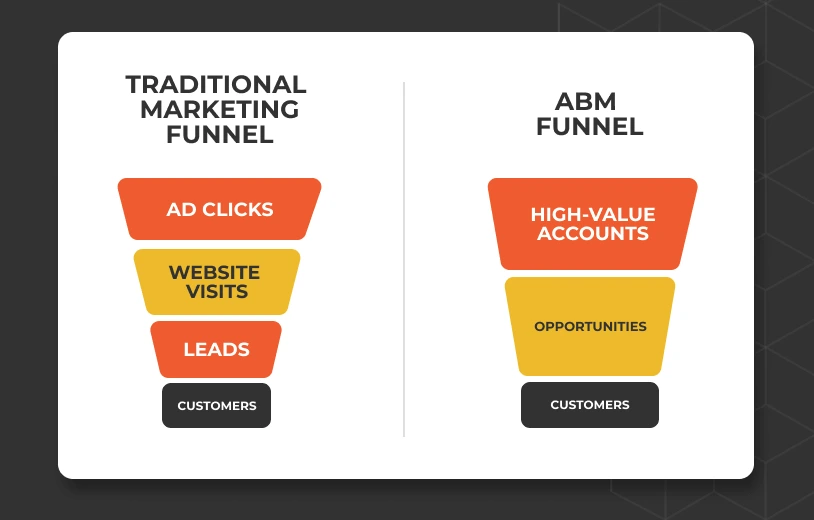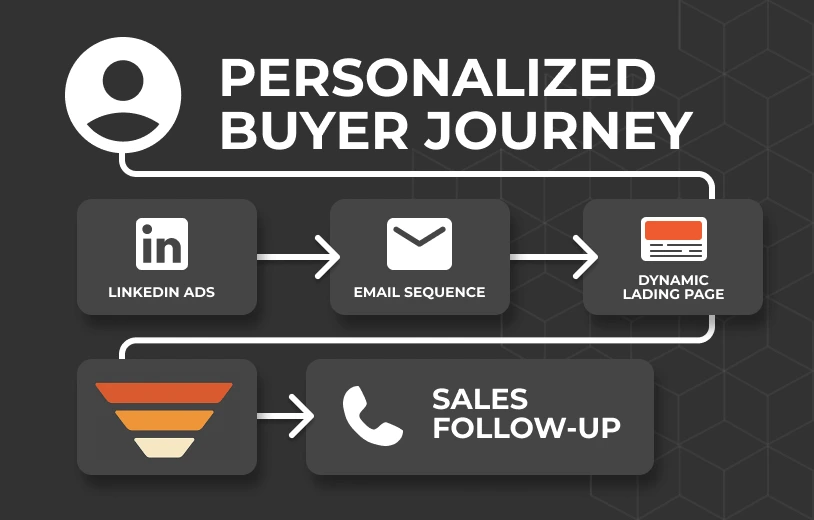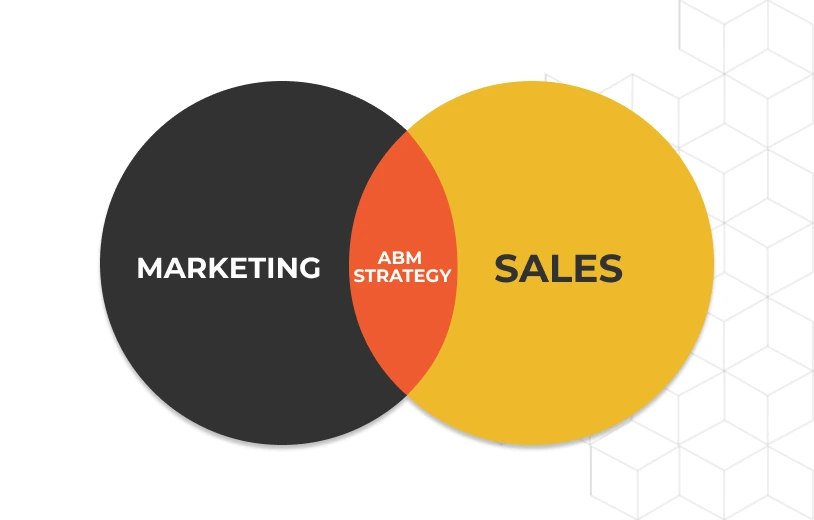Key Takeaways
- ABM Marketing Is the Future of B2B: By 2025, 75% of B2B companies are expected to adopt ABM as their primary go-to-market strategy, driven by its higher ROI and alignment with the behavior of modern buyers.
- Traditional B2B Strategies Are Failing: Broad, generic outreach methods no longer work. Today’s buyers demand personalized, self-directed experiences.
- ABM Delivers Where It Matters: With precision targeting, personalization at scale, and unified sales and marketing efforts, ABM shortens sales cycles and boosts conversion rates.
- Data and Technology Are Game-Changers: ABM’s success relies on a smart tech stack—AI, intent data, and unified analytics that guide decision-making and drive performance.
- It’s About Relationships, Not Just Leads: ABM prioritizes meaningful engagement with high-value accounts and nurtures long-term relationships that lead to greater lifetime value.
Would you like to know the real power behind data-driven PPC campaigns?
Small eCommerce businesses are turning $500 PPC investments into $2,000 in sales. That’s a 300% ROI that proves the value of strategic digital advertising.
Success with PPC demands more than launching ads and crossing fingers. Savvy marketers know that data sits at the heart of every high-performing campaign. This methodical approach helps you pinpoint ideal audiences, optimize budget allocation, and measure true campaign impact.
Your PPC campaign success relies on four essential metrics:
- Cost Per Acquisition (CPA) – The actual cost to acquire a customer. Lowering CPA while maintaining quality leads is key to profitability.
- Conversion Rate (CVR) – Measures how effectively clicks turn into valuable actions, such as purchases or sign-ups.
- Return on Ad Spend (ROAS) – Evaluates how much revenue you generate for every dollar spent, making it a critical KPI for eCommerce and sales-driven businesses.
- Quality Score & Ad Relevance – Ensures that you receive the best possible CPC for high-intent traffic, influencing both ad placement and cost.
- Customer Lifetime Value (CLV) – Helps justify higher CPC if long-term value outweighs upfront costs.
These metrics create the foundation for ROI-focused decisions that drive real business growth.
Are you ready to unlock the full potential of your PPC campaigns? Let’s explore proven PPC marketing services that turn casual clicks into valuable conversions through data-backed decision-making.
Why Traditional B2B Marketing Is Outdated

Traditional B2B marketing approaches—mass email blasts, cold calling, and generic ad campaigns—are rapidly losing their effectiveness. As buyer behavior evolves, these tactics are failing to connect with today’s digitally native, research-driven audiences.
Broad Targeting Leads to Poor ROI
The classic “spray and pray” marketing approach no longer delivers. Research shows that 71% of B2B buyers expect personalized experiences, but most traditional campaigns remain generic and untargeted.
As a result, companies are wasting large portions of their marketing budgets—often up to 67%—on audiences that don’t align with their ideal customer profile.
Despite increasing investments, nearly half of B2B marketers struggle to meet their pipeline growth targets. That’s because traditional lead generation strategies come with systemic problems:
- Fragmented digital channels split audience attention
- Acquisition costs keep climbing with little return
- Cold outreach and impersonal messaging are easily ignored
- Teams focus too much on acquiring new leads instead of nurturing existing customers with higher lifetime value
This outdated thinking not only inflates costs but also creates disconnected, inconsistent buyer journeys—a major liability in today’s high-stakes market.
Content Fatigue Is Real
We’re living in the age of information overload. B2B buyers are inundated with whitepapers, webinars, emails, and ads at every stage of their journey. 54% of buyers feel overwhelmed by marketing content, which often leads to frustration, decision paralysis, or worse—abandonment.
Even more concerning, 75% of B2B ads receive a score of one star or less on emotional connection metrics.
That means most content does little to stand out, inspire trust, or move prospects through the funnel. Brands often end up competing on spend rather than creativity or relevance, which accelerates content burnout and buyer apathy.
The result? Lower engagement, longer sales cycles, and missed revenue opportunities.
Misalignment with Modern Buying Committees
Perhaps the most damaging disconnect is that traditional B2B marketing still targets individual decision-makers when in reality, the average B2B purchase involves 11 or more stakeholders, sometimes even up to 20 in larger organizations.
These complex, cross-functional buying teams require unified messaging, personalized engagement across departments, and alignment across both marketing and sales teams. Old-school tactics simply can’t navigate this level of complexity.
Worse yet, the modern buying journey is often fragmented:
- 70% of research happens before engaging sales
- Millennials now influence 73% of all B2B buying decisions
- Gen Z buyers expect seamless, on-demand experiences
With budget constraints tightening, 86% of B2B purchases get paused mid-funnel due to internal misalignment or mixed messaging from vendors.
Legacy marketing methods are not equipped to manage this level of sophistication.
Smart businesses see these warning signs for what they are: a clear call to action to shift toward ABM marketing—a strategy purpose-built for today’s buying dynamics. ABM not only accounts for the complexity of the modern buyer’s journey but also optimizes every touchpoint for relevance, timing, and value.
What Makes ABM Marketing So Effective?

Precision Targeting
ABM starts with identifying your ideal customer profile (ICP) and prioritizing high-value accounts. This focus increases marketing efficiency and improves alignment with sales teams.
👉 Want a partner who understands targeting? Learn how we help clients build scalable digital strategies.
Personalized Content at Scale
ABM enables tailored messaging across every stage of the buyer’s journey, using CRM insights and AI-driven analytics. Marketers can dynamically serve content that resonates with each stakeholder’s specific pain points.
3. Sales & Marketing Alignment
ABM dissolves silos. Joint planning between sales and marketing creates consistent messaging and seamless customer experiences. Businesses with aligned teams report a 67% better deal-closing rate and 58% higher retention.
4. Data-Driven Decision-Making
ABM thrives on intent data, predictive analytics, and performance measurement. This precision improves outreach timing and boosts ROI tracking across channels.
ABM vs. Traditional B2B Marketing: Real Results
- Shorter Sales Cycles: By targeting only accounts showing intent, ABM eliminates friction and accelerates conversions.
- Higher Conversion Rates: 84% of marketers report better ROI using ABM over traditional marketing.
- Increased Customer Lifetime Value (CLV): With a stronger focus on post-sale nurturing, ABM unlocks upsell and cross-sell opportunities while improving retention.
The Tech Stack Behind ABM Marketing in 2025
Four technology pillars power modern ABM programs:
- AI & Predictive Analytics: Drive segmentation, personalization, and lead scoring.
- Intent Data Platforms: Identify active buyers before they engage.
- Personalization Engines: Serve customized experiences across touchpoints.
- Integrated Measurement Tools: Link marketing activity directly to revenue.
The Future Is Account-Based

As buyer behavior evolves, so must your marketing strategy.
ABM isn’t just another tactic—it’s a fundamental shift in how we think about outreach, engagement, and conversion in the B2B space.
Companies that adopt Account-Based Marketing (ABM) now are well-positioned to lead the market in 2025 and beyond. Those that don’t risk being left behind by buyers who demand personalized, account-focused experiences.
Let’s Build an ABM Strategy That Works
Fahrenheit Marketing helps B2B companies create high-performance ABM campaigns that generate real ROI. Whether you’re just exploring ABM or ready to scale your current strategy, our experts are here to help.
Schedule a free discovery call with our ABM marketing team now.
FAQs
How does Account-Based Marketing (ABM) differ from traditional B2B marketing?
ABM focuses on treating high-value accounts as individual markets, delivering personalized experiences and tailored content to each one. Unlike traditional broad-targeting approaches, ABM employs precision targeting and data-driven strategies to engage specific accounts, yielding higher conversion rates and ROI.
What are the key technologies driving ABM’s success in 2025?
ABM’s dominance is powered by four main technologies: AI and predictive analytics for actionable insights, intent data platforms to track buyer behavior, personalization engines for tailored experiences, and integrated measurement systems for comprehensive ROI tracking and attribution.
Why are traditional B2B marketing strategies becoming less effective?
Traditional B2B marketing is failing due to the declining ROI of broad-targeting campaigns, information overload causing content fatigue among buyers, and misalignment with modern buying committees that involve multiple stakeholders and complex decision-making processes.
How does ABM impact sales cycles and customer lifetime value?
ABM shortens sales cycles by delivering relevant content at the right time in the buyer’s journey. It also increases customer lifetime value by fostering deeper post-sale engagement, enabling strategic upselling and cross-selling, and transforming satisfied customers into brand advocates.
What percentage of B2B organizations are adopting ABM strategies?
According to recent data, 75% of B2B organizations are expected to adopt account-based marketing (ABM) as their primary go-to-market strategy by 2025. Additionally, 80% of mid-sized to large B2B organizations have already adopted or piloted at least one account-based marketing (ABM) program.
